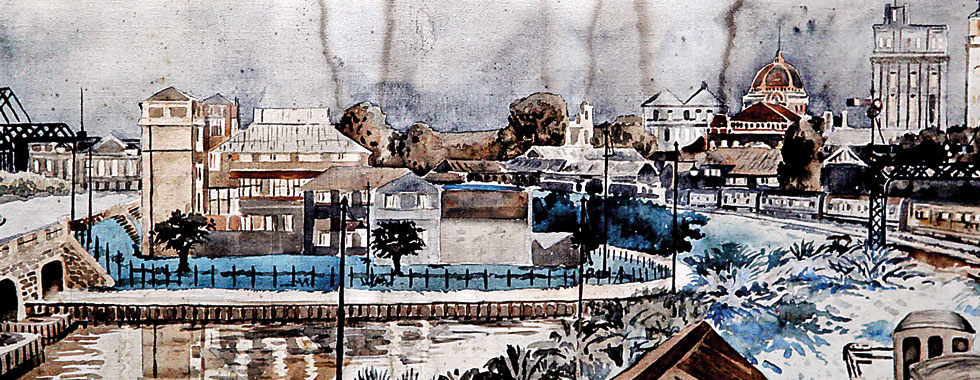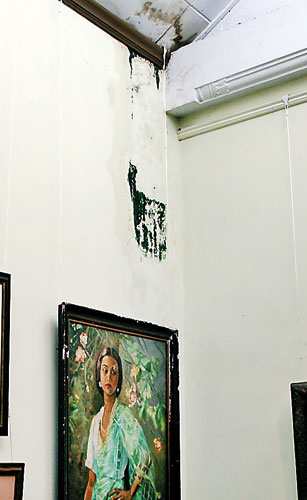Step into a national shame
Who should took the blame for the sorry state of the National Art Gallery?
One visit is enough to put off even the most zealous of art lovers. The imposing building on Ananda Coomaraswamy Mawatha (or Greenpath, as it’s more popularly known) is a mere outer shell; walk in past the stone lions, through the heavy mahogany doors and into the badly lit halls and you’ll realise why a book must never be judged by its cover. The National Art Gallery is a farce.

Water marks: One of the 75 paintings left on display at the Art Gallery
Yes, you will find no less than three magnificent George Keyts, a couple of imposing paintings by Mudliyar A.C.G.S. Amarasekara. But these are just the handful of works worthy of exhibition at an institution titled the National Art Gallery, say several well known artists and experts. The rest are fading monuments to former greats of television, stage and politics- placed here by those currying favour with relatives, say the critics. Of the 200 or more paintings that the gallery originally housed, only 75 are in exhibition-they’ve been there for as long as anyone can remember. The rest, some 165 paintings, are at the Walisinharachandra Museum in Negombo under the watchful eye of restorer Ananda Colombage who had been handed them for restoration very recently.
The Gallery came into being due to the steadfast commitment of the Ceylon Society of Arts and the Arts Council of Ceylon. The initial call for an Art Gallery was made in 1911, and the first stage of the gallery project was completed in 1932. Gate Mudliyar A.C.G.S. Amarasekara was tasked with designing the gallery, and what an architectural accomplishment it is. The building is designed in such a way that natural light reflects on the paintings. Peer up at the banisters and you’ll catch a glimpse of the curved ceilings-an ingenious architectural trick to make maximum use of the natural light. And in its heyday, the gallery was the stamping ground for great Lankan artists including David Paynter, Mudliyar Amarasekara and Justin Deraniyagala.
In the 1950’s, by an Act of Parliament, the Arts Council was placed under the Department of Cultural Affairs along with the National Art Gallery. In 1971, according to Secretary of the Ceylon Society of Arts Aruna Gamage, the gallery was handed over to the government of Sirimavo Bandaranaike as the society was unable to manage its upkeep. Since then it has come under the Department of Cultural Affairs.
Today, it is sadly deserted. In the long hall that holds all 75 paintings, there is not a single painting that isn’t in a stage of decay- fraying canvases, broken frames and water leaking right through is what the visitor sees.

Who cares: Water leaking onto a painting. Pix by M.A. Pushpa Kumara
“What the gallery desperately needs is funds,” says former Dean of the University of Peradeniya’s Faculty of Arts, Prof. Ashley Halpe. “And even more importantly it needs a curator who is aware of the current trends in Sri Lankan paintings, someone who can recommend works to be purchased. That collection is hopelessly outdated.” He makes it a point to avoid going to the gallery, he notes wryly, unless he absolutely has to.
Prof. Albert Dharmasiri, Chairman of the National Panel on Arts and Sculpture believes that there are plans for a massive scale renovation. He agrees with Professor Halpe that the gallery’s collection of art is desperately in need of an update.
At the Department of Cultural Affairs last week, Director Wijith Kanugala confirms that indeed, a project to renovate and expand the existing Art Gallery has just been approved. “We’re planning on expanding the existing building to accommodate two permanent galleries, a conference hall, a preservation room and a smaller gallery for younger artists,” he explained. Mr. Kanugala acknowledges the gallery is in a sorry state. “We accept that it is in a poor condition for a national gallery; we understand that, and we’re working on rectifying it.” This renovation was personally requested by the President, he says, confirming that the Rs. 323 million project will begin sometime this year.
Two new curators will be appointed to update the collection. This is a vital need for despite its prime location on Greenpath, the gallery is little more than a mausoleum of forgotten art. We visited over ten times and it was empty on all these occasions. The blame cannot be laid on a national dearth of impressive artwork to exhibit-Sri Lanka has produced some of the region’s finest artists; George Keyt, Ivan Peiris, Ranil Deraniyagala, Senaka Senanayake, Chandragupta Thenuwara and Anoli Peiris come to mind. The authorities could not provide the Sunday Times with an account as to the date the last purchase of a painting was made-nor could they provide a catalogue of the works at the gallery.
“The problem is in the administration,” says Professor B.D. Nandadeva, senior lecturer at the Department of Fine Arts in the University of Kelaniya. “That’s the big problem that needs to be solved and then we can begin tackling the rest.”
The administration of the gallery itself is a mystery. There is no gallery director, curator or registrar. A caretaker appointed by the department, Mr. Sirisena is clearly a man who appreciates art (he can name most artists in the gallery and this is helpful because the paintings on the wall lack titles or even the artist’s name-), but he is hardly qualified to be responsible for national treasures. Five other clerical staff don’t seem to venture beyond their office space.
What of conservation of the works there? The two most vital components of an art gallery are humidity and light controls, says Professor Nandadeva who has studied conservation extensively in reputed universities abroad. At the gallery a handful of ceiling fans feebly ward off the stifling heat while dust and other debris from the busy road floats in through the wide open doors. “Can you imagine the damage being done to these paintings?” he asks in despair.
The Department, for its part, seems to have woken up to the need for not just expansion but also preservation. They’ve partnered with the University of Moratuwa to create the appropriate conditions for paintings to be preserved. Dr. Sithumini Rathnamalala, a Chartered Architect from the university involved in the project explained that they were working to international standards to provide the correct lighting and humidity for the paintings on exhibit, along with creating a state of the art preservation room to house the works not being displayed at that time.
Rohan Amarasinghe, an artist who has tirelessly campaigned for the restoration of the National Art Gallery, however, remains pessismistic. “For over a decade I have written extensively to these very authorities,” he says. “I didn’t ask for grand renovations, I merely asked them to improve the existing structure; for small changes to be made- like getting the frames replaced or at least for additions to the collection every now and again.” What guarantee do we have that the authorities will act in a responsible manner towards the upkeep when they have allowed the gallery to rot away for so many decades, he asks.
The blame does not rest with the authorities alone. Save for a handful, local artists have shown little interest. As one humble worker in the gallery said to us – if the artists cannot unite in creating a better standard for the National Art Gallery, then why must we bother? The answer lies in the mentality of us Sri Lankans, says Professor Nandadeva. We need to start thinking outside the norm.
“We’re so caught up in our 2500-year-old history that we forget history was created 70 years ago when the ’43 Group was formed. History was created when our artists took brush to canvas in the aftermath of war. History is being created every day and art is the best representation of all. For while we die, art lives on.” The real question is will art live on at the National Art Gallery, that fading monument to a forgotten era of Sri Lanka?
Follow @timesonlinelk
comments powered by Disqus


